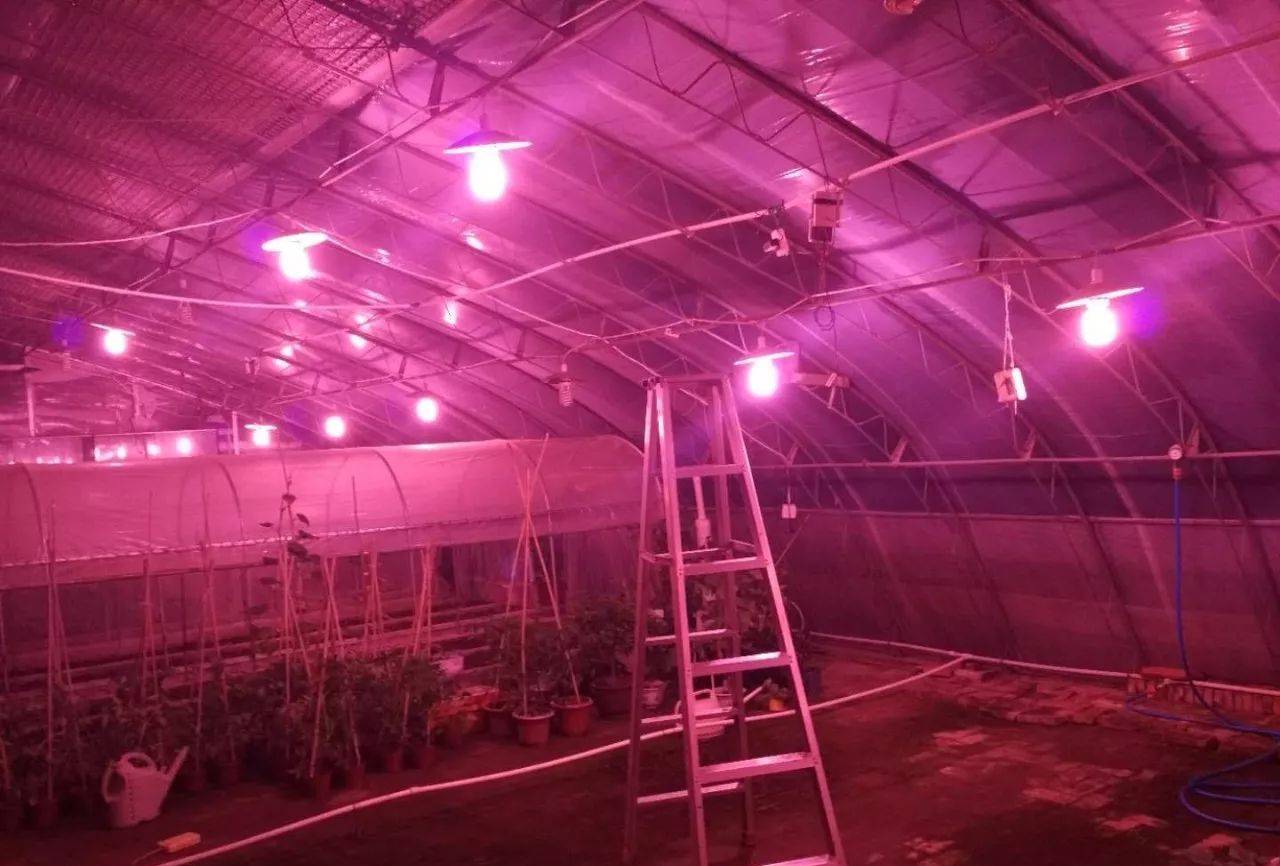As we move into the autumn of 2025 in the Northern Hemisphere, the colder season is just around the corner. When temperatures drop sharply at night, your greenhouse plants face serious frost risks that can stunt growth or even destroy your crops. According to the University of Massachusetts, nighttime temperatures in single digits can cause newly transplanted cuttings to freeze, leading to irreversible cold damage.
To help greenhouse growers prevent losses and maintain steady growth even during harsh winter nights, our INSONSHADE greenhouse experts have compiled 13 effective, practical methods, from basic heat storage and insulation to advanced smart heating systems. And we believe these strategies will help you keep your greenhouse warm, protect your plants from frost, and ensure strong, healthy growth throughout the winter of 2025.
How to Keep a Greenhouse Warm at Night
Before diving into each method in detail, here we provide a quick comparison of all 13 greenhouse heating methods, including their implementation difficulty, applicability, and overall effectiveness. This overview will help you quickly identify which solutions best fit your greenhouse type, size, and budget.
| Method | Category | Implementation Difficulty | Best For |
|---|---|---|---|
| Optimize Orientation and Sunlight | Design / Passive Heating | Easy | All greenhouse types |
| Heat Storage | Passive Heating | Easy | Small to medium greenhouses |
| Compost Hot Bed | Biothermal Heating | Medium | Eco-friendly or low-cost setups |
| Greenhouse Heaters | Active Heating | Medium | Large or commercial greenhouses |
| Soil Heating Cables and Mats | Active Root Heating | Medium | Root-zone temperature control |
| Forced-Air Heating Systems | Active Heating / Air Circulation | Hard | Large greenhouses |
| Grow Lights | Lighting and Heating | Medium | Low-light winter conditions |
| Insulation Materials | Structural / Passive Heating | Easy | All greenhouse types |
| Zoned Heating or Inner Tent | Energy Efficiency | Medium | Large greenhouses / energy saving |
| Natural Windbreaks | External Protection | Easy | Windy or cold regions |
| Soil Mulching | Passive Root Insulation | Easy | Small and medium greenhouses |
| Greenhouse-Livestock Integrated System | Eco Integration | Hard | Farm-scale operations |
| Monitoring Temperature and Humidity | Smart Control | Easy | All automated setups |
Great — now let’s take a closer look at each method and explore how to apply them effectively to keep your greenhouse warm during the 合winter nights.
1. Optimize Orientation and Sunlight
Before considering any heating equipment, the first step to keeping a greenhouse warm is maximizing natural sunlight and heat gain during the day. Proper orientation helps capture more solar energy during winter, which significantly reduces the need for artificial heating at night.
In cold seasons, the orientation of commercial greenhouses should aim to maximize solar radiation during winter and enhance heat retention. For example, the optimal deviation angles for solar greenhouses in China vary with latitude. Specifically, at latitudes of about 36.8°–38° N (Northern China), the best orientation is 4°–6° south by west; around 41.8° N, 8°–10° south by west; and at higher latitudes near 43.6° N, 2°–4° south by east. These orientation angles allow greenhouses to capture more low-angle sunlight in winter, improving solar energy absorption by the roof and walls and reducing nighttime heating demand by approximately 5%–12%.

Schematic profile of a Chinese solar greenhouse
Although a due south orientation provides the strongest sunlight in summer, it can result in insufficient lighting in high-latitude winters. Slightly rotating the structure to the south-west or south-east helps distribute sunlight more evenly between morning and afternoon, preventing excessive heating or cooling on one side. During design, the orientation should be determined according to the local latitude, prevailing wind direction, and the light requirements of the cultivated crops. Combined with insulated walls and adjustable shading screens, an optimized orientation can significantly enhance solar-thermal utilization, lower heating costs, and improve crop productivity throughout the winter season.
2. Heat Storage
Heat storage is one of the simplest and most energy-efficient methods for keeping a greenhouse warm during cold nights. The concept is to absorb solar energy during the day and release it slowly at night, thereby stabilizing the internal temperature.
Water is one of the most effective heat storage materials due to its high heat capacity. You can place water barrels or tanks inside the greenhouse to absorb heat during the day and release it at night. This passive approach provides warmth without consuming additional energy and works particularly well for small to medium-sized greenhouses.
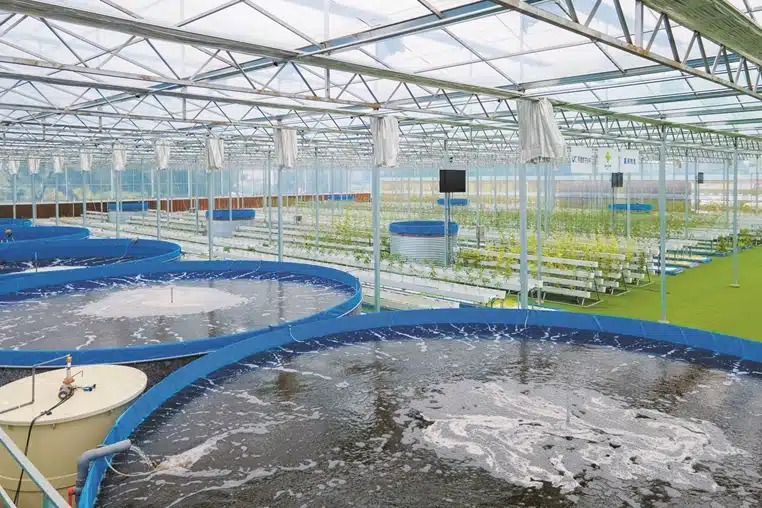
Heat Storage
In addition to water, soil with high organic content can also serve as a heat storage medium. By improving soil texture and increasing its depth, you can enhance its thermal mass and help maintain a more stable environment. Heat storage is both cost-effective and sustainable, making it an ideal foundation for other heating strategies.
3. Compost Hot Bed Heating
Compost heating beds utilize the residual heat generated during the aerobic decomposition of organic materials to provide low-cost and renewable heating for greenhouses or seedling beds. As microorganisms break down straw, manure, and garden waste, the internal temperature of the compost pile can rise rapidly to around 30–35°C (86–95°F) and sometimes reach peaks of approximately 34°C (93°F), depending on the substrate composition and aeration conditions.
During the most active heating phase—typically one to three weeks after feeding—the compost bed can maintain a steady heat source between 30°C and 45°C. This heat can be transferred through the soil layer or a water circulation system to warm the growing medium above it. According to a study, compost heating beds can increase soil temperature by approximately 2–5°C compared with unheated controls, while greenhouse air temperature can remain up to 16°C higher than the outside air, effectively extending the growing season in cold climates.
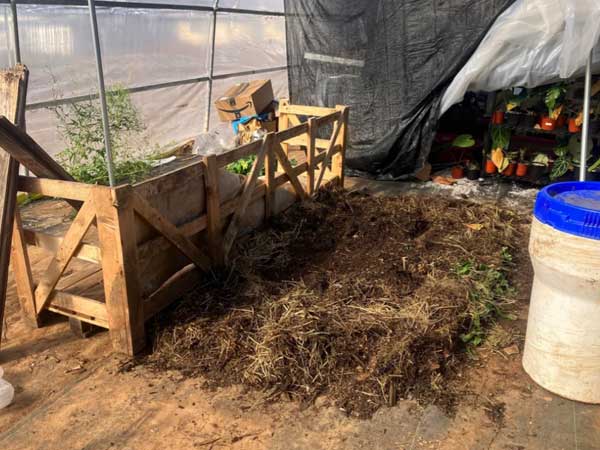
ASP Compost heated greenhouse by NoPhilosopher6636
To construct a compost heating bed, create a base layer of organic materials 30–40 cm thick beneath the planting beds or in designated composting zones. The composting process releases consistent thermal energy over several weeks, providing both heat and nutrient enrichment. Cover the compost pile with soil or mulch to retain warmth and minimize odor emission. This biothermal method is particularly suitable for growers seeking sustainable, low-cost heating solutions that also improve soil fertility and resource recycling.
4. Greenhouse Heaters
When natural heat storage cannot maintain the required temperature at night, external heating systems become essential for protecting crops. Common options include electric, gas, fuel, biomass, and hybrid heaters, each differing in thermal power, response time, and operating cost. The best solution depends on greenhouse size, local climate, and fuel availability, and many growers now combine multiple energy sources for balanced efficiency and reliability.
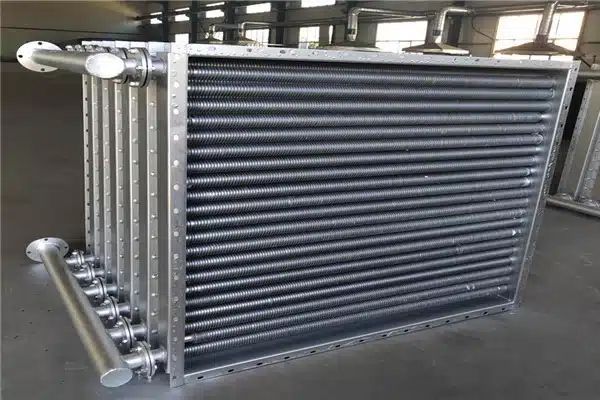
Modern greenhouse heaters can maintain a stable temperature at night
Safety and efficiency are key to winter heating. Fuel or gas heaters must have proper ventilation and CO detection to prevent carbon monoxide buildup. Recent smart temperature controllers equipped with sensors and feedback systems can automatically adjust heat output, reducing energy waste and maintaining a stable environment. Such intelligent and thermostatic heaters are among the most effective ways to cut heating costs in the winter of 2025.
5. Soil Heating Cables and Mats
Soil heating cables are installed about 10 cm below the root zone and connected to temperature sensors and thermostatic controllers. When the soil temperature drops below a preset threshold, the cables automatically activate to raise the root zone temperature by approximately 5–6°C, maintaining it within an optimal range of 7–23°C. This stable underground warmth prevents root freezing, reduces day–night temperature differences, and promotes root development, nutrient uptake, and crop quality. In advanced systems, soil infrared heating can be combined with air convection to deliver nearly twice the heating power of convection alone, ensuring that both soil and air reach ideal growth conditions during cold nights.
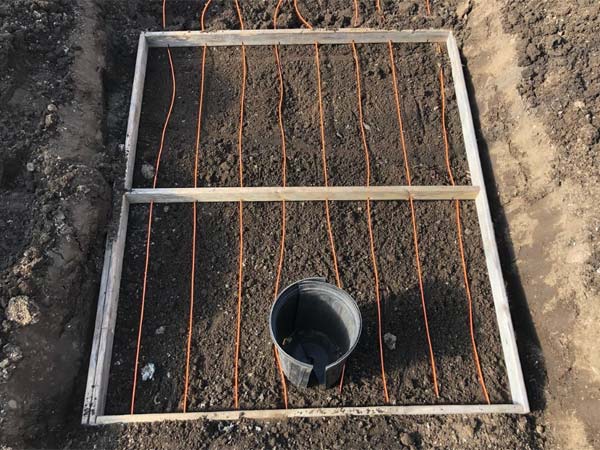
Soil Heating Cables by Instagram wowwallace
Flat heating mats offer another effective solution by delivering direct and uniform warmth to seedling trays or beds, typically maintaining the surface soil at approximately 36°C for germination and early growth. In larger facilities, deep-earth tube heat exchangers (ETHE) draw on stable ground temperatures from around 3 meters below the surface, achieving an overall thermal efficiency of up to 73%. Together, these root-zone heating technologies maintain ideal soil conditions through the winter, extend the growing season, and reduce total energy consumption while improving crop yield and quality.
6. Forced-Air Heating Systems
Forced-air heating systems are widely used in large or commercial greenhouses for rapid and uniform temperature control. These systems use fans to distribute warm air evenly, preventing hot and cold spots that can stress plants. They can operate with gas, fuel, or electric heat sources and are often integrated with automated thermostats for better control.
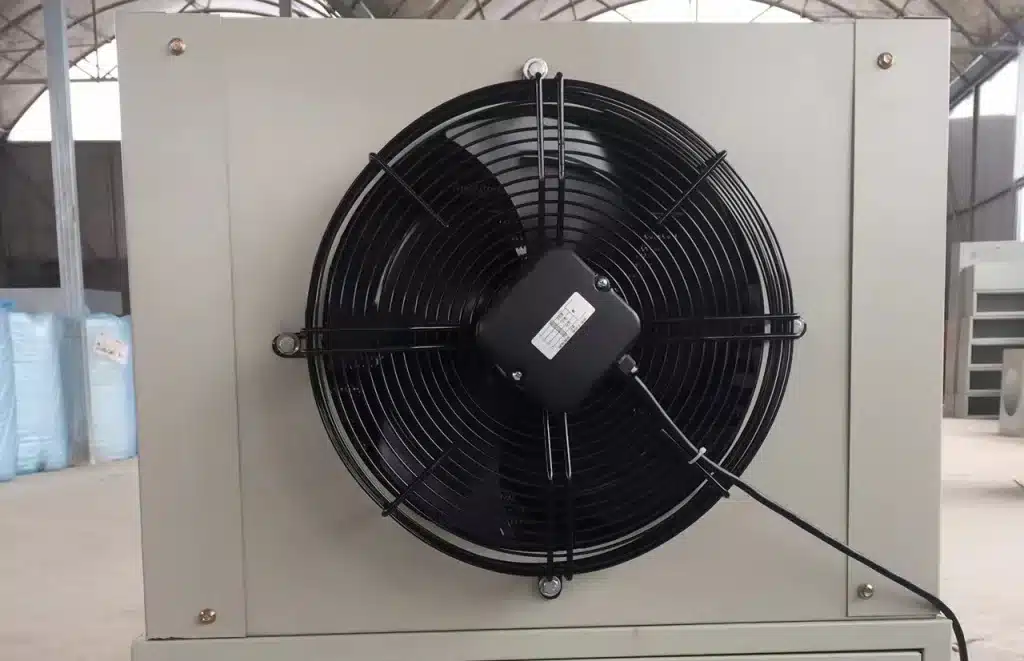
Forced-Air Heating Systems
To maximize efficiency, fans should be positioned for balanced airflow and regularly maintained to avoid dust buildup. Connecting the system to temperature and humidity sensors ensures responsive adjustments to real-time conditions. For the winter of 2025, modern forced-air heaters, combined with smart controllers, are increasingly favored for their fast response and improved energy efficiency.
7. Grow Lights
Grow lights offer a dual benefit for greenhouses: they provide essential illumination for photosynthesis while also generating supplemental heat. During winter or in regions with limited sunlight, this extra warmth helps maintain favorable night temperatures. Fluorescent and LED lights produce moderate heat, whereas high-intensity discharge lamps generate more thermal energy, making them suitable for larger facilities.
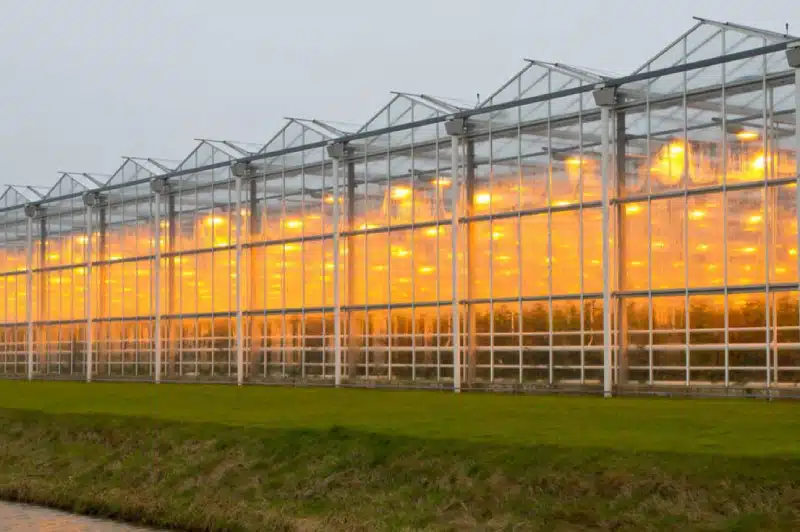
Grow Lights
Metal halide (MH) lamps are ideal for vegetative growth, while high-pressure sodium (HPS) lamps are more suitable for supporting flowering and fruiting. Combining these with automatic lighting timers ensures consistent light cycles and stable heat output. In winter 2025, energy-efficient LED systems with adjustable spectra remain a sustainable option for maintaining growth and warmth simultaneously.
8. Insulation Materials
Effective insulation is essential for retaining heat in greenhouses during cold nights. Common materials include glass, polycarbonate panels, and polyethylene films, which serve as the main barrier against heat loss. Double-layer coverings offer better insulation than single layers, while polycarbonate sheets provide the optimal combination of light transmission and thermal performance. For regions with severe winters, adding an extra layer of insulation, such as blankets or thermal screens, can further reduce nighttime heat loss.

Different of Greenhouse Covering
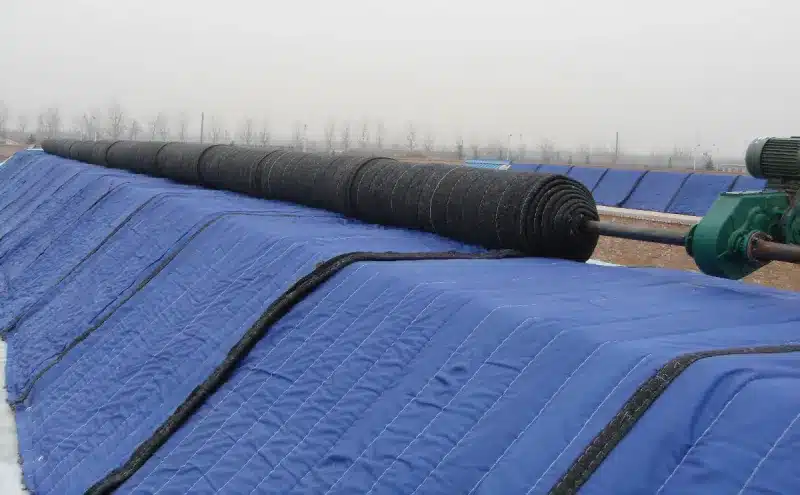
Greenhouse Thermal Blankets

Greenhouse Thermal Screen
Insulation blankets are suitable for crops with lower light requirements, as they block some sunlight. Automated thermal screens, on the other hand, can open during the day to capture sunlight and close at night to retain heat. Regular maintenance of joints, seals, and coverings also prevents unwanted air leakage. These simple but effective measures help reduce heating demand and stabilize the greenhouse environment through the winter season.
9. Zoned Heating or Inner Tent
Zoned heating systems divide a greenhouse into smaller sections and warm only the areas where temperature control is most critical. This approach minimizes energy waste by avoiding uniform heating across the entire structure. In large greenhouses, inner tents made of transparent film or fabric can be installed to create a smaller enclosed area that is easier to heat and maintain at stable temperatures during cold nights.
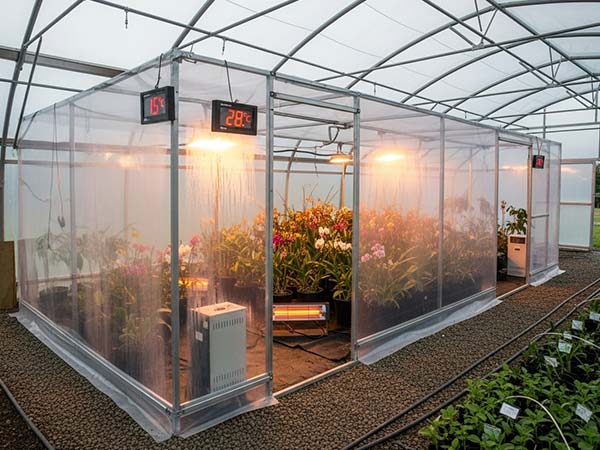
Greenhouse Zoned Heating
This energy-saving method enables growers to adjust heating intensity according to crop type, growth stage, or occupancy. Combining zoned heating with automated sensors and thermostats ensures precise control and uniform growth conditions throughout the plant.
10. Natural Windbreaks
Strong winter winds can cause significant heat loss in greenhouses by increasing convection and air infiltration. Establishing natural windbreaks, such as evergreen trees or shrubs, or artificial barriers on the upwind side of the greenhouse, helps reduce this effect. Evergreen species are preferred for their year-round foliage and ability to block cold airflow without creating excessive shade.
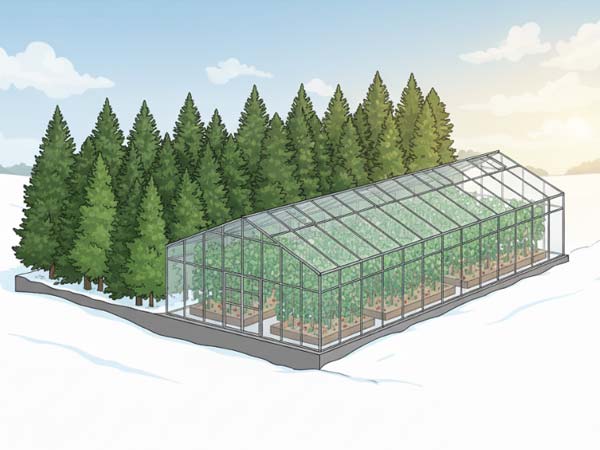
Windbreak on the north side of a greenhouse in the Northern Hemisphere.
The windbreak should be positioned to protect against prevailing winds while allowing sufficient sunlight to pass through. Ideally, its height should be 1.5 to 2 times that of the greenhouse and placed at a distance equal to five times its height. Well-designed windbreaks can reduce wind speed by up to 50%, improve temperature stability, and further decrease heating costs during the cold months.
11. Soil Mulching
Soil mulching is a simple yet highly effective method for retaining heat within the root zone during cold nights. Materials such as straw, wood chips, dry leaves, or agricultural films create a thermal barrier that slows down heat loss and helps maintain soil moisture. By insulating the topsoil, mulching can increase the root-zone temperature by 2–4°C compared with bare soil, preventing root freezing and improving nutrient uptake.
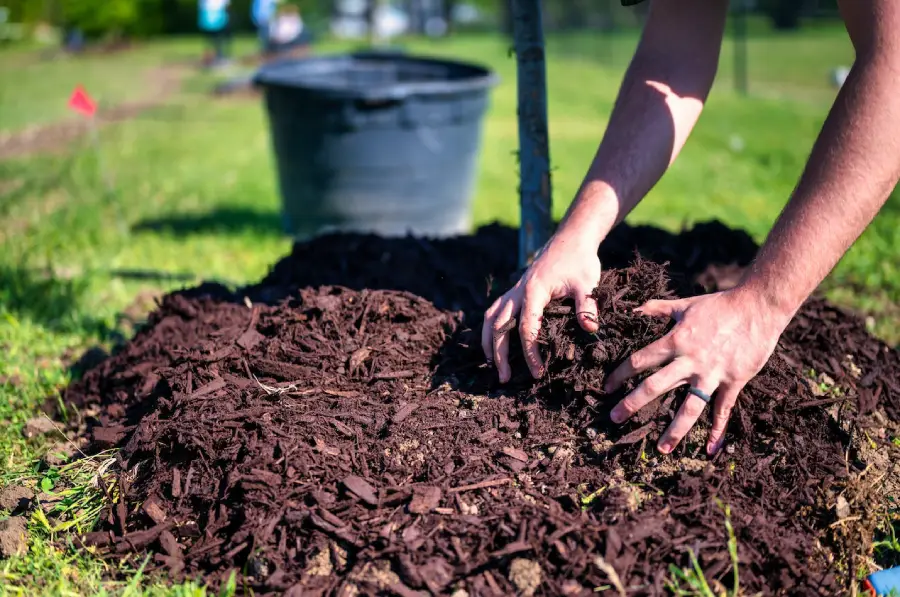
Mulch to Protect Plants in Winter
Mulching also reduces evaporation, stabilizes soil structure, and supports microbial activity even in winter. For small or medium-sized greenhouses, combining mulching with soil heating cables provides excellent thermal stability at low energy cost. This method extends the growing period, enhances root health, and contributes to overall energy efficiency during the winter.
12. Greenhouse-Livestock Integrated System
The greenhouse-livestock integrated system combines plant cultivation with animal husbandry to efficiently recycle heat and organic matter. Heat generated from animal respiration, body temperature, and manure fermentation can be utilized to naturally warm the greenhouse. This symbiotic system enhances overall energy efficiency, reduces dependence on external fuels, and lowers agricultural waste emissions.
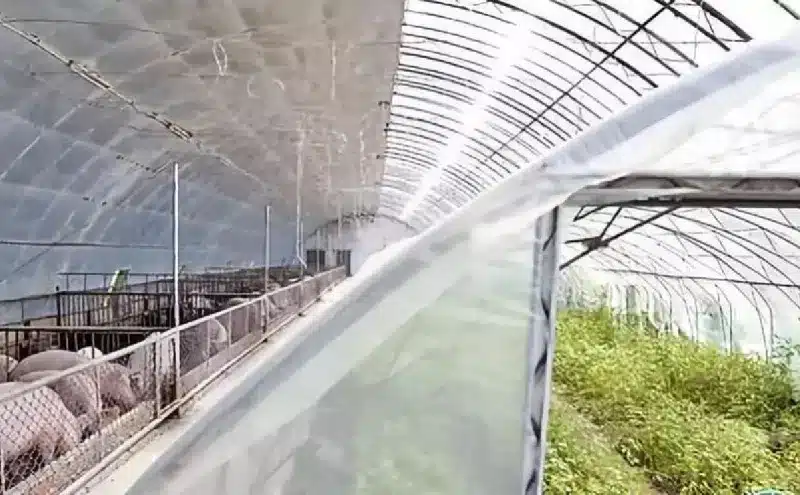
Greenhouse-Livestock Integrated System
Implementing such systems requires careful design to separate livestock from plants while allowing controlled heat transfer and ventilation. Although initial investment can be high, the long-term benefits include lower operating costs, reduced carbon emissions, and stable winter temperatures. This eco-friendly approach represents a sustainable direction for agricultural production.
13. Monitoring Temperature and Humidity
Accurate temperature and humidity monitoring is crucial for maintaining an optimal greenhouse environment. Modern sensors and smart controllers can record real-time data, automatically triggering heating, ventilation, or irrigation systems when conditions fall outside preset thresholds. This automation ensures consistent climate control with minimal manual intervention.
Advanced monitoring systems now integrate wireless connectivity and mobile applications, enabling growers to remotely adjust greenhouse settings. Combined with predictive algorithms, they help reduce energy consumption, prevent frost damage, and enhance crop productivity. Intelligent environmental control remains one of the most effective tools for achieving efficient and precise greenhouse management on cold nights.
Frequently Asked Questions (FAQ)
1. What temperature should a greenhouse be at night?
Nighttime temperature is one of the most important factors influencing crop growth, development, and yield. While specific needs vary by crop, most greenhouse vegetables share a relatively consistent optimal range of conditions. The table below summarizes the recommended nighttime temperature ranges for common crops.
| Crop | Recommended Night Temperature (°C) | Recommended Night Temperature (°F) |
|---|---|---|
| Tomato | 16–20 (minimum safe 8–13) | 61–68 (minimum safe 46–55) |
| Cucumber | 18–22 (ideal 19–21) | 64–72 (ideal 66–70) |
| Sweet Pepper | 16–20 | 61–68 |
| Strawberry | 10–13 | 50–55 |
| Lettuce | 7–11 | 45–52 |
| General greenhouse vegetables | 15–20 | 59–68 |
A study shows that maintaining a temperature of 15–20 °C (59–68 °F) at night helps prevent chilling injury and minimizes energy consumption. Heat-loving crops, such as cucumbers or melons, benefit from temperatures of 18–22 °C. In contrast, cold-tolerant crops like lettuce or strawberries can grow well between 10–13 °C but should not be exposed to temperatures below 5 °C (41 °F). To maintain proper conditions, use thermal screens, insulation films, or low-power heating systems, and ensure adequate ventilation to prevent condensation.
2. How to Keep a Greenhouse Warm Without Electricity?
In the absence of electricity, consider alternative energy sources like solar power, diesel, gasoline, or wood. For instance, heaters equipped with solar panels can absorb solar energy during the day and release heat at night. Additionally, employ various methods to prevent heat loss at night, such as covering the greenhouse with insulating materials or using windbreaks to protect it from cold winds.
3. How to Keep A Small Garden Greenhouse Warm at Night?
Simple, cost-effective methods are ideal for small garden greenhouses. Lightweight insulating materials, such as bubble wrap and insulation blankets, significantly reduce heat loss. Placing heat storage mediums (like water barrels) inside is also effective. Grow lights can provide necessary light for plants and help increase the greenhouse temperature. If your budget allows, consider installing a small heater or a DIY heater. However, ensure the distribution of heat is evenly throughout the greenhouse using specific tools.
4. How to Heat Commercial Greenhouses at Night?
Large commercial greenhouses, due to their scale and complexity, typically require more advanced insulation solutions. These include installing professional heating systems, such as forced-air or gas heaters, for rapid and effective temperature regulation over large areas.
Utilize insulating curtain systems to efficiently manage light and heat in greenhouses. For instance, open insulating screens during the day to let in sunlight and heat, and close them at night to prevent heat loss. Most greenhouses also install high-intensity discharge lamps to promote plant growth and add heat.
5. How can you keep plants warm in an unheated greenhouse?
As mentioned earlier, several methods can help maintain a warmer environment at night in greenhouses without the use of heating systems. One simple and effective method is to use insulating materials, such as bubble wrap or insulation blankets, to cover the greenhouse at night, thereby reducing rapid heat loss. Additionally, water or organically rich soil can be used as a heat storage medium. These substances absorb heat during the day and release it at night, helping to maintain the greenhouse’s warmth.
Conclusion
Keeping your greenhouse warm through cold nights is essential for stable plant growth, higher yields, and reduced energy waste. In this guide, we explored 13 proven methods—from passive solar heating and soil warming to intelligent temperature control—that help maintain optimal conditions even during harsh winter weather. Each method has its unique advantages and can be combined for optimal results.
For small home greenhouses, simple solutions such as heat storage barrels, insulation covers, or soil heating cables may be sufficient. Commercial growers can benefit more from zoned heating systems, automated thermostats, or hybrid solar-assisted heaters to achieve energy efficiency and stable performance during the 2025 winter. Choosing the right combination depends on your climate, greenhouse structure, and production goals.
If you are planning to upgrade your greenhouse with advanced thermal curtains, contact INSONSHADE specialists for expert advice and factory-direct supply. We provide durable greenhouse films, thermal screens, and other professional solutions to help you maintain ideal growing conditions throughout the year.
